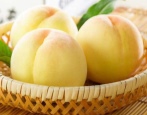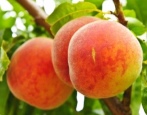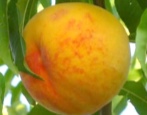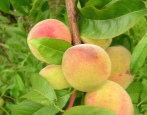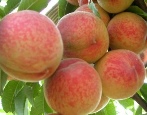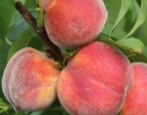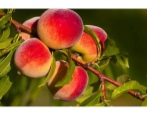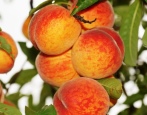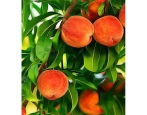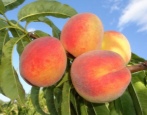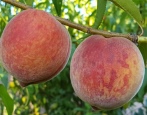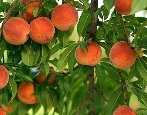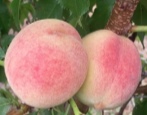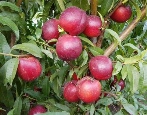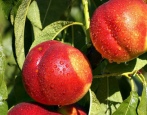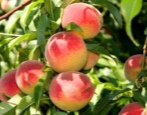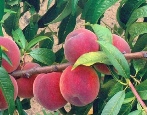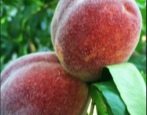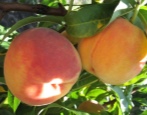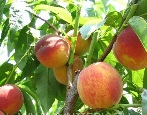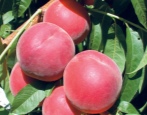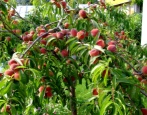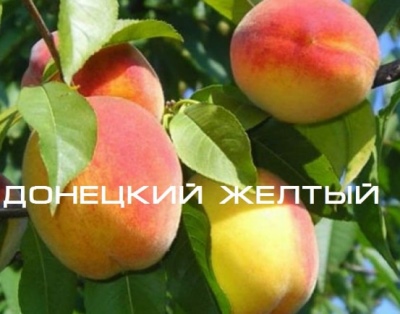
- Growth type: vigorous
- Ripening period: mid-late
- Self-fertility: self-fertile
- Appointment: for fresh consumption, for canning
- Yield: high
- Transportability: good
- Early maturity: 3 years after planting
- Bone size: large
- Separability of the bone from the pulp: not separable
- Winter hardiness: high
Donetsk yellow peach is a popular garden variety, tested by time and many years of experience of summer residents. It is distinguished by its large size, calibratedness and excellent appearance of the resulting crop. Trees take root well in many regions of Russia, but the fruits have to be removed before full maturity, otherwise the skin is strongly wrinkled and damaged.
Breeding history
The variety was obtained in 1960 by L. I. Taranenko, an employee of the Donetsk branch of the Institute of Horticulture. In the selection work, seedlings of seeds brought from the Krasnodar Territory were used.
Description of the variety
Peach trees of Donetsk yellow are characterized by a high growth rate. They are large, strong, abundantly form shoots. The crown is formed by a thick, rounded shape. The leaves are large, lanceolate, colored in a dark green tone. The flowers are large, with pink petals, pinkish, giving the tree a special decorative effect.
Fruit characteristics
Peaches of this variety have a rounded shape, flattened at the poles, with a well-defined ventral seam. They are characterized by large sizes, the weight of each reaches 150-220 g. The skin is thin, slightly pubescent, in unripe peaches it is pale golden, with greenery, at the stage of full ripeness on the side from the sunny side a blurred carmine-scarlet blush spreads. The pulp is yellowish-orange inside, rather dense in consistency. The bone is large, inseparable.
Taste qualities
The fruits are suitable for canning, juicing, fresh eating. Their taste is pleasant, sweet, with a barely noticeable sourness, juicy. There is a light pleasant aroma. The tasting score of the fruit is 4.8 points.
Ripening and fruiting
The harvest from trees is harvested for the first time in 3 years from the moment of planting. The variety is considered medium late, bears fruit annually, in the 2nd decade of August.
Yield
Each tree produces up to 60 kg of fruit.
Growing regions
The variety is zoned for the Central and Chernozem regions.
Self-fertility and the need for pollinators
Donetsk yellow is a self-fertile peach. It does not require the obligatory presence of trees with similar flowering dates nearby. But the possibility of cross-pollination is worth considering if you want to increase yields.
Growing and care
Agricultural technology of the variety is difficult, especially for inexperienced gardeners. It is grown only in regions with mild winters, where the temperature does not drop to -20 degrees. Planting dates are chosen based on the climate. In cold weather, spring transfer of young trees to the soil is preferable. In the south, autumn planting is possible, upon completion of sap flow, when the average atmospheric temperatures reach +10 degrees.
The choice of location also matters. Do not place a peach tree where alfalfa, melons or nightshade crops previously grew. The place should be sunny, free from any shade. Saplings are also chosen very carefully. Their roots should be alive, not dry, the bark should be greenish, the grafting site should be whole and smooth.
The planting site is prepared in the fall, even if the plant itself is planned to be transferred to the site in the spring. The pit is formed with a diameter of about 0.7 m at a depth of 50 cm. A support is installed in the center, to which the seedling will be tied up in the first years.The extracted soil is combined with a bucket of rotted manure, wood ash, potassium chloride and superphosphate are added to the mixture in a ratio of 300/50/50 g. The resulting substrate is poured into the center of the pit with a mound.
After 2-3 weeks, you can plant. A young tree with straightened roots is set on the prepared mound. They are covered with earth so that the grafting area is above the edge of the hole. The surface of the trunk circle is compacted, a small groove is laid along its contour for irrigation. 30 liters of water are added to it. After complete absorption of the liquid, the trunk is fixed on a support, the space around it is mulched.
After planting, it is important to keep the soil in the root zone moist. Watering is carried out every 3 days throughout the month. Mature trees are moistened twice a month, starting in May, throughout the growing season, by introducing 5 liters of water into the dug groove. Humidification stops 4 weeks before harvest.
The peach tree is fed every 2-3 years. It will be enough to add a few buckets of compost or humus to the root zone. Trees are pruned annually in the fall.
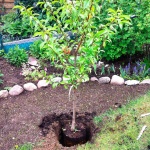
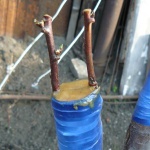
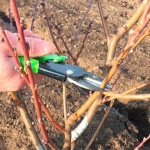
Disease and pest resistance
Since this peach variety has been bred for a long time, it is much inferior to newer breeding achievements in resistance to diseases. Trees are affected by curly leaves, powdery mildew.
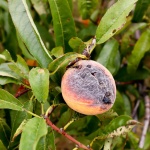
Requirements for soil and climatic conditions
The variety is cold-hardy, winter-hardy, when the shoots freeze out, they quickly recover. Sensitive to heat during the growing season. The need for soil moisture is average. The soil is preferable to black earth.
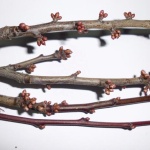
Review overview
Summer residents speak very well of the Donetsk yellow peach variety. It is considered one of the most winter-hardy among large-fruited varieties; it is grown throughout the territory of Ukraine, southern Russia. In addition, fruit trees give a bountiful harvest annually, without gaps, in some cases the number of ovaries has to be rationed so that the branches do not break under the weight of peaches.Taste qualities are also highly appreciated, the fruits are pleasant fresh, but it is not customary to leave them on trees for a long time.
The disadvantages of this variety, according to gardeners' reviews, include the defeat of almost all characteristic diseases. Also, the owners note the non-simultaneous ripening of the pulp inside the fruit. With recurrent frosts, fruit ovaries may crumble. In this case, the plant puts the main forces on the formation of shoots, giving abundant lateral growth. It must be cut out.
